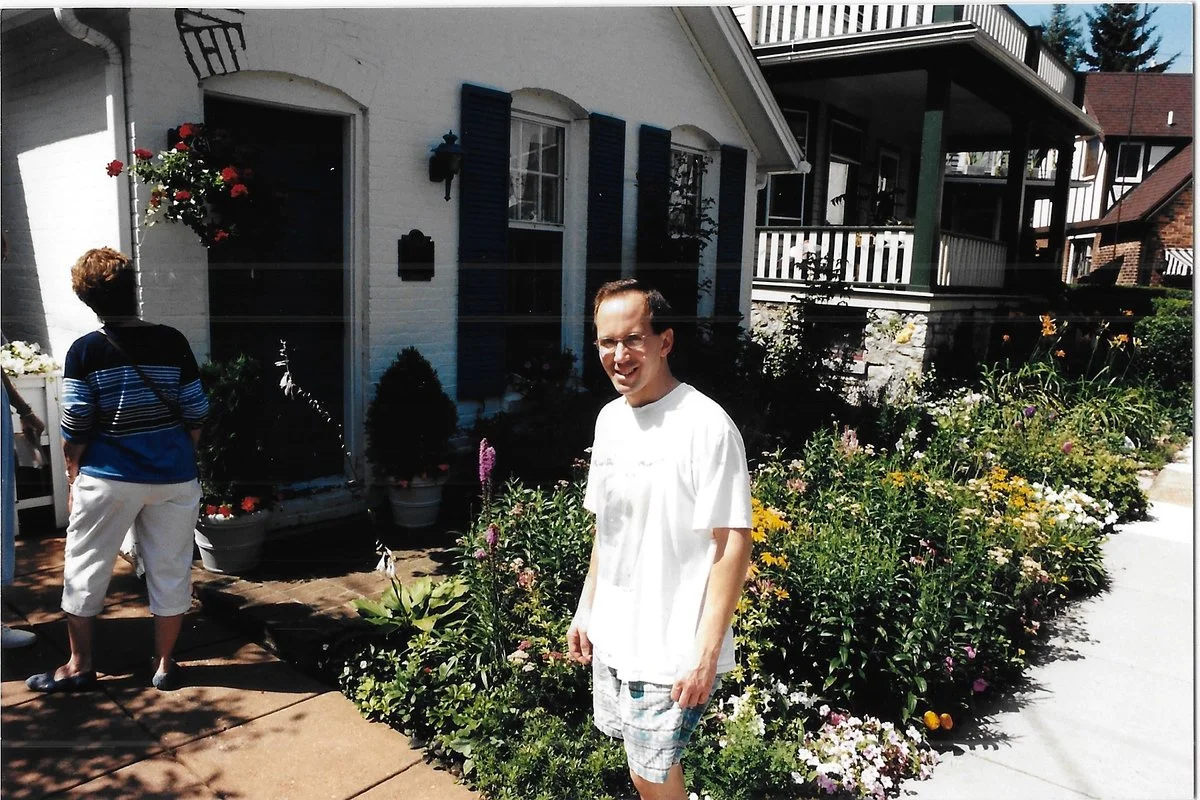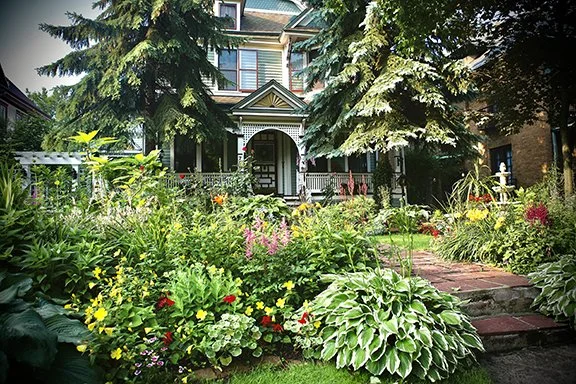How to Transform Your Neighborhood with a Garden Tour (Lessons from America's Largest)
What started as a crazy idea became a movement of Community Change
Marvin Lunenfeld and Gail McCarthy, founders of Garden Walk Buffalo with their Norwood Avenue Block Club neighbors. (Photo by Don Zinteck)
Picture this: It’s 1995 in Buffalo, New York. The city is struggling, some neighborhoods are declining, home values are not increasing, and many locals think twice about walking around city streets. Then a block club with garden enthusiasts does something audacious—they invite strangers to walk through their backyards.
Fast forward to today: Garden Walk Buffalo, which is totally free—not even tickets are required—draws 45,000-55,000 visitors annually from around the U.S. and beyond, and has sparked neighborhood improvements, created tens of millions in economic impact, helped change perceptions of the city, and become the largest garden tour in America.
Garden Walk has also given back, in the form of grants, more than $170,000 to block clubs and community groups for garden-oriented beautification. Property values in tour areas have soared, once-neglected blocks now bloom with pride, and what began with 29 gardens has grown to more than 300 gardens into a movement spanning much of the city—and inspiring 15+ regional garden tours that showcases, altogether, around 1,000 gardens annually.
“Garden Walk has also given back, in the form of grants, more than $170,000 to block clubs and community groups for garden-oriented beautification.”
Garden Walk past Co-Chair and treasurer Elaine Friedhaber (2000-05) and Arlan Peters, President (2000-05). (Photo by Don Zinteck)
The best part? You can do this in your city too.
The Magic Formula That Changed Everything
Here's what Garden Walk Buffalo (GWB) figured out that most community events miss: People don't just want to see pretty gardens—they want to believe their garden can be beautiful too.
When visitors walk through tour gardens, something powerful happens. They don't just admire the roses and tomatoes; they start imagining what their own yard could become. Neighbors who've never spoken suddenly find themselves discussing compost techniques over the fence. Property owners who've let things slide start making improvements.
But creating this transformation requires more than just opening garden gates. Here's how to build a garden tour that actually changes your community.
Start Small, Think Big (Your First-Year Game Plan)
Don't try to conquer your entire city in year one. GWB started with just 29 gardens, and that turned out to be perfect. Here's why:
Manageable logistics: Fewer moving parts mean fewer things can go wrong
Proof of concept: Success with 20-some gardens makes recruiting 30-some next year much easier
Community intimacy: Small tours feel special, exclusive even
Scale: Ideally, fewer gardens in a small footprint can make a tour walkable, as opposed to driving from garden to garden
“Choose neighborhoods that tell a story. Maybe it’s a historic district, a recovering neighborhood, or three blocks that represent different garden styles. Give people a reason to walk the route.”
Jeffrey Tooke, an early Garden Walk Buffalo participant in his Union Street garden circa 1996. Jeff went on to be co-chair of Garden Walk (2006-07), and President of Gardens Buffalo Niagara (2015-22) and treasurer in between! (Photo: GWB Archives)
A popular West Delavan Avenue garden for many years on the Walk. (Photo by Don Zinteck)
Finding Your First Gardeners
The secret isn't advertising—it's personal connection. Here's where GWB found their initial participants:
The "Proud Garden Owner" Hunt
Create an entry form. GWB’s were paper forms for many years. Garden registration forms are now all online. Free and low cost options get the job done. GWB uses Google Forms.
Walk your target neighborhood and literally knock on doors where you see great gardens.
Attend community meetings like block clubs and mention your idea (you'll be surprised who approaches afterward)
Partner with local nurseries—they know their customers' gardens
Check social media for local garden groups and people posting garden photos with location tags
The Magic Question: "Would you be willing to share your garden with neighbors who love gardening as much as you do—and would like to show off your community?"
Notice what's missing? No criteria, no judging, no garden perfection required. Let people self-select based on their pride and enthusiasm.
“No criteria, no judging, no garden perfection required. Let people self-select based on their pride and enthusiasm.”
Garden Walk Buffalo, 2005. Photo by Don Zinteck.
The Non-Negotiables That Make or Break Your Tour
Keep It 100% Walkable
This is where new tours can fail. The moment people have to get back in their cars, you've may lose them.
No Sales Allowed (Seriously, None)
It’s tempting to let gardeners sell plants, or add craft booths, or allow "just a small garage sale." Don't. The moment your garden tour becomes a shopping experience, it stops being about gardens. Garden Walk Buffalo has held this line for more than 30 years. The gardens remain the focus of the event.
Garden Walk Buffalo map 2025, 8,000 copies, 11.25”x16.25”, printed on newsprint. Available as a print-friendly PDF online and as an online plotted Google Map. Design by JCharlier.Design.
Professional Materials = Instant Credibility
Here's a hard truth: Hand-drawn maps and photocopied flyers make your tour look amateur, no matter how gorgeous the gardens are.
Invest in a graphic designer for:
A logo that reflects your city's character
Professional map design (this becomes your most important marketing piece)
Consistent signage system
Social media templates
Think of this as your biggest first-year expense, and the best money you'll spend.
Money Matters: Budget Like a Pro
A First-Year Reality Check
Develop a budget and fund it. Money can be solicited from neighborhood businesses, from civic and government groups, or from individual contributions. You may want to charge admission for the event; Garden Walk Buffalo does not. Expect to spend $3,000+ on a quality first-year tour. Here's the breakdown:
Must-Haves ($2,000+):
Professional design and printing
Insurance
Garden signage
Website setup
Nice-to-Haves ($1,000+):
Merchandise for sale
Marketing/advertising
Finding the Money
Corporate sponsors love garden tours because they're positive community events that attract affluent visitors.
The sponsorship pitch: "For $X, your logo goes on X,XXX maps plus prominent website placement and social media recognition."
Target these categories first:
Garden centers: Your most natural partners
Real estate agencies: Tours showcase neighborhood desirability
Local banks: Demonstrable community investment
Home improvement stores: Visitors are literally your target customers
Restaurants: Visitors have to eat somewhere!
Individual donations: Make it easy for visitors to give on the spot with a visible donation bowl and QR code at map pick-up locations.
Building Your Dream Team
Essential Roles
You can't do this alone, and you shouldn’t try. Garden Walk Buffalo succeeds because they distribute leadership:
Tour Coordinator/Chair (that may be you!): Big picture management, final decisions
Garden Whisperer: Recruits and supports garden participants
Marketing Maven: Handles publicity, social media, press relationships
Money Manager: Sponsors, budgets, financial tracking
Day-Of Director: Event logistics, headquarter and volunteer coordination
Day-Of Volunteers: You may need volunteers to staff HQs especially if many of the event organizers have their own gardens on the tour.
A Meeting Suggestion
GWB holds 7-8 meetings per year: one monthly from January through September. That's it. More meetings kills enthusiasm. Most gardeners prefer doing to talking.
Take care of legal matters.
GWB started out operating as a division of a neighborhood businessman’s association for tax and insurance purposes. GWB had a checking account under their tax ID number. GWB is now a subcommittee of Gardens Buffalo Niagara, a NYS 501c3.
Make sure some kind of liability insurance is in place for your event.
Individual homeowners insurance covers anyone invited onto a private property, but if something does happen, you’ll need insurance in case someone comes looking to sue you. One or two-day event insurance is not particularly expensive.
Marketing That Actually Works
The Free Publicity Goldmine
Garden tours are media catnip—they're visual, positive, and appeal to multiple demographics. Here’s your free marketing strategy:
Six weeks before your tour:
Send press releases to all publications (newspapers, magazines) and all broadcast media (TV, radio, online)
Set up social media accounts and post on every community Facebook group, Instagram, and Nextdoor—any social media to which you have access
Partner with local nurseries for flyer/map distribution
Submit to all community event calendars
Two weeks before:
Offer media preview tours to TV stations and newspapers
Start daily social media countdown with garden photos
Start collecting emails and use MailChimp or Constant Contact or another service to send out email notices. end reminder emails to your growing list. For small numbers of emails some of these services are free.
Send a communication to each participant with details about what to expect. Let them know what is going on with your tour—where to get maps, how much t-shirts cost, where available bathrooms are located. They’ll be the source for questions from visitors.
The secret weapon: Find local garden enthusiasts, or local celebrities, with social media followings and invite them for sneak peeks in exchange for posts. GWB got a big boost from having a local weatherman on the garden tour and he promoted the tour in his weather forecasts.
Your Website Strategy
Even a simple website prevents 90% of repeated questions. Essential pages:
Downloadable and printable map or link to custom Google Maps
FAQ section (trust us, you'll need this)
"How to participate" for next year's gardeners
Sponsor recognition
Contact form that actually gets monitored
Event Day Magic
Creating the Experience
Your garden tour isn't just about gardens—it's about creating an experience that makes people feel part of something special.
Set up a centrally-located headquarters where visitors can:
Get maps and ask questions
Use restrooms and get water
Park their cars or connect easily to public transportation
Buy merchandise (if you’re selling)
Connect with volunteer garden experts
Managing the Crowd
Success brings challenges. Here's how Garden Walk Buffalo handles thousands of visitors:
Clear signage at garden entrances
Volunteer “ambassadors” at headquarters
Emergency contact system for quick problem resolution
The Payoff: Why This Matters
Three years after Garden Walk Buffalo started, something remarkable happened. Neighbors who had never spoken were collaborating on shared garden spaces. Property owners were landscaping front yards for the first time in decades—even at homes where a garden was not on the tour. Local nurseries reported sales increases during tour season.
The ripple effects include:
Measurable property value increases in tour areas
New community connections and friendships
Increased civic pride and neighborhood investment
Regional economic impact for restaurants, shops, and in GWB’s case, hotels
Economic boost to local garden businesses
Media attention that changes outside perceptions
Your Turn: Making It Happen
Starting a garden tour feels overwhelming, but remember: Garden Walk Buffalo began with regular people who thought their neighborhood deserved better. They had no special expertise, no major funding, and no guarantee of success. None were professional gardeners. They were all just hobbyists like you.
Here’s your action plan:
This week: Walk your target area and identify gardens you'd want to visit. We use hanging doorknockers these days.
Next week: Approach those gardeners with your idea
This month: Form your core team and pick your date
Next month: Start building your garden list and sponsor relationships
Afterwards: Reward & thank your gardeners. A month before have an event where gardeners can mingle and pick up any posters, maps, garden signs and purchase each year’s t-shirts ahead of your tour (if you’re selling them). A short time after the tour, GWB has end-of-season gathering for all those who helped with and took part in the event. It’s a chance to say thank you to those who contributed time, effort, and money or who shared their gardens. We share garden banter and anecdotes and it’s also a way to get feedback to use the following year.
The hardest part is starting. But if Buffalo can create America's largest garden tour, imagine what’s possible in your community.
Ready to plant the seeds of neighborhood transformation? The only question is: Will your city be home to the next great garden tour success story?
Have questions about starting your own garden tour? Garden Walk Buffalo has resources and connects with emerging tours nationwide. Sometimes the best way to grow a community is to share what you've learned.
Garden Walk Buffalo takes place the last weekend in July and welcomes more than 45,000 visitors annually to more than 300 gardens across Buffalo. Learn more at GardenWalkBuffalo.com
This article was started in the early 2000s by then Garden Walk Buffalo President Arlan Peters and has been added onto over the years by past president, Jim Charlier.







